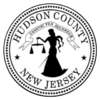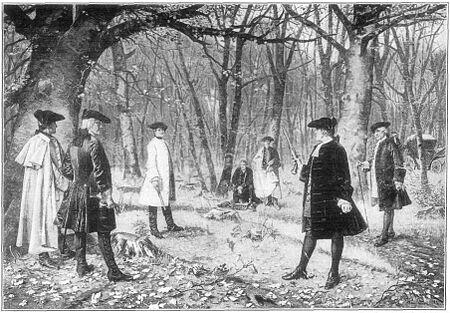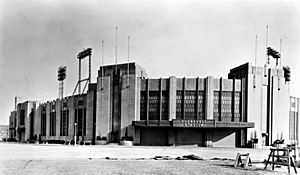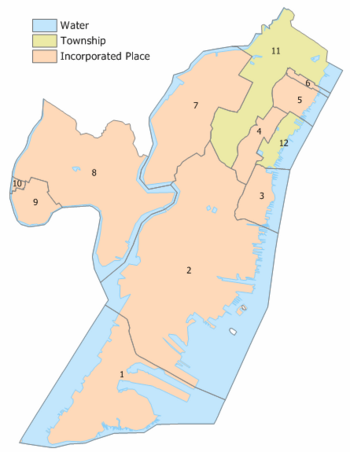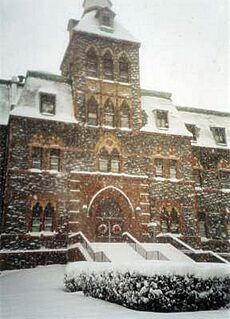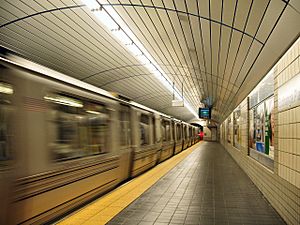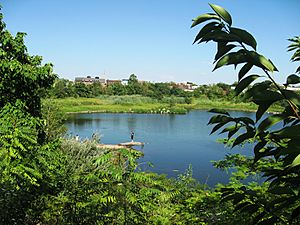Hudson County, New Jersey facts for kids
Quick facts for kids
Hudson County
|
|||
|---|---|---|---|

View north on Hudson Waterfront
|
|||
|
|||

Location within the U.S. state of New Jersey
|
|||
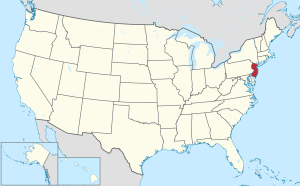 New Jersey's location within the U.S. |
|||
| Country | |||
| State | |||
| Founded | 1840 | ||
| Named for | Henry Hudson | ||
| Seat | Jersey City | ||
| Largest city | Jersey City (population and area) | ||
| Area | |||
| • Total | 62.35 sq mi (161.5 km2) | ||
| • Land | 46.19 sq mi (119.6 km2) | ||
| • Water | 16.15 sq mi (41.8 km2) 25.9% | ||
| Population
(2020)
|
|||
| • Total | 724,854 | ||
| • Estimate
(2023)
|
705,472 |
||
| • Density | 11,625.6/sq mi (4,488.7/km2) | ||
| Time zone | UTC−5 (Eastern) | ||
| • Summer (DST) | UTC−4 (EDT) | ||
| Congressional districts | 8th, 9th, 10th | ||
Hudson County is the smallest and most densely populated county in the U.S. state of New Jersey. It lies west of the lower Hudson River, which was named for Henry Hudson, the sea captain who explored the area in 1609. Part of New Jersey's Gateway Region in the New York metropolitan area, the county seat is Jersey City, which is the county's largest city in terms of both population and area. The county is part of the North Jersey region of the state.
As of the 2020 United States census, the county was the state's fourth-most-populous and fastest-growing county in the previous decade, with a population of 724,854, its highest decennial count ever and an increase of 90,588 (+14.3%) from the 2010 census count of 634,266, which in turn reflected an increase of 25,291 (+4.2%) from the 2000 census population of 608,975.
Home to 15,693 residents per square mile (6,130/km2) in 2020 and covering 46.19 square miles (119.6 km2) of land, Hudson County is New Jersey's geographically smallest and most densely populated county. Hudson County shares extensive mass transit connections with Manhattan, located across the Hudson River, as well as with most of Northern and Central New Jersey.
Contents
Geography and climate
Climate
The average temperature of Hudson County is 51.89 °F, which is approximately the same as the state average of 51.93 °F, and lower than the national average of 54.45 °F.
The county is located on the U.S. East Coast, approximately halfway between the Equator and the North Pole, which results in climate that is influenced by wet, dry, hot, and cold airstreams, and highly variable daily weather. Of New Jersey's five distinct climate regions, Hudson County is located in the Central region, which runs from New York Harbor and the Lower Hudson River to the great bend of the Delaware River near the state capital of Trenton. The high number of urban areas in this region are characterized by a high volume of industry and vehicular traffic that produce large amounts of pollutants. These substances, along with the large amounts of asphalt, brick, and concrete that compose buildings in the area, retain more atmospheric heat, which make it a regularly warmer "heat island" than surrounding suburban and rural areas. The northern border of the Central Zone is often the boundary between freezing and non-freezing precipitation in the winter, and between comfortable and comfortable sleeping conditions in the summer.
Hudson County experiences precipitation an average of 116 days a year, during which it receives an annual average of 48 inches of rain, compared to the national average of 38, and 26 inches of snow, compared to the national average of 28. The summer high temperature in July is about 86 degrees, and its winter low in January is 25. On average, there are 219 sunny days per year in the county, compared with the national average of 205.
| Weather chart for Jersey City | |||||||||||||||||||||||||||||||||||||||||||||||
|---|---|---|---|---|---|---|---|---|---|---|---|---|---|---|---|---|---|---|---|---|---|---|---|---|---|---|---|---|---|---|---|---|---|---|---|---|---|---|---|---|---|---|---|---|---|---|---|
| J | F | M | A | M | J | J | A | S | O | N | D | ||||||||||||||||||||||||||||||||||||
|
3.7
38
27
|
3.2
42
29
|
4.4
50
35
|
4.5
61
45
|
4.2
71
54
|
4.4
79
64
|
4.6
84
69
|
4.4
83
68
|
4.3
75
61
|
4.4
64
50
|
4
54
42
|
4
43
32
|
||||||||||||||||||||||||||||||||||||
| temperatures in °F precipitation totals in inches source: The Weather Channel |
|||||||||||||||||||||||||||||||||||||||||||||||
|
Metric conversion
|
|||||||||||||||||||||||||||||||||||||||||||||||
Average temperatures in the county seat of Jersey City have ranged from a low of 27 °F (−3 °C) in January to a high of 84 °F (29 °C) in July, although a record low of −15 °F (−26 °C) was recorded in February 1934 and a record high of 106 °F (41 °C) was recorded in July 1936. Average monthly precipitation ranged from 3.21 inches (82 mm) in February to 4.60 inches (117 mm) in July.
Landforms and borders

According to the U.S. Census Bureau, as of the 2020 Census, the county had a total area of 62.35 square miles (161.5 km2), of which 46.19 square miles (119.6 km2) was land (74.1%) and 16.15 square miles (41.8 km2) was water (25.9%). Based on land area, it is the smallest of New Jersey's 21 counties, less than half the size of the next smallest (Union County) and the eighth-smallest of all counties in the United States.
Hudson is located in the heart of New York metropolitan area in northeastern New Jersey. It is bordered by the Hudson River and Upper New York Bay to the east; Kill Van Kull to the south; Newark Bay and the Hackensack River or the Passaic River to the west; its only land border is shared with Bergen County to the north.
The topography is marked by the New Jersey Palisades in the north with cliffs overlooking the Hudson to the east and less severe cuesta, or slope, to the west. They gradually level off to the southern peninsula, which is coastal and flat. The western region, around the Hackensack and Passaic is part of the New Jersey Meadowlands. Much of the land along the county's extensive shoreline and littoral zone was created by land reclamation.
The highest point, at 260 feet (79 m) above sea level, is in West New York; the lowest point is at sea level. North Bergen is the city with the second most hills per square mile in the United States behind San Francisco.
Ellis Island and Liberty Island, opposite Liberty State Park, lie entirely within Hudson County's waters, which extend to the New York state line. Liberty Island is part of New York. Largely created through land reclamation, Ellis Island covers a land area of 27.5 acres (11.1 ha), with the 2.74-acre (1.11 ha) natural island and contiguous areas comprising a 3.3 acres (1.3 ha) exclave of New York. Shooters Island, in the Kill van Kull, is also shared with New York. Robbins Reef Light sits atop a reef which runs parallel the Bayonne and Jersey City waterfront.
Much of the county lies between the Hackensack and Hudson Rivers on a geographically long narrow peninsula, (sometimes called Bergen Neck), which is a contiguous urban area where it is often difficult to know when one's crossed a civic boundary. These boundaries and the topography-including many hills and inlets-create very distinct neighborhoods. Kennedy Boulevard runs the entire length of the peninsula. Numerous cuts for rail and vehicular traffic cross Bergen Hill.
Given its proximity to Manhattan, it is sometimes referred to as New York City's sixth borough.
History
Etymology
Hudson County is named after the explorer Henry Hudson who charted much of the region.
The Lenape and New Netherland
At the time of European contact in the 17th century, Hudson County was the territory of the Lenape (or Lenni-Lenape), namely the bands (or family groups) known as the Hackensack, the Tappan, the Raritan, and the Manhattan. They were a seasonally migrational people who practiced small-scale agriculture (companion planting) augmented by hunting and gathering which likely, given the topography of the area, included much (shell) fishing and trapping. These groups had early and frequent trading contact with Europeans. Their Algonquian language can still be inferred in many local place names such as Communipaw, Harsimus, Hackensack, Hoboken, Weehawken, Secaucus, and Pamrapo.
Henry Hudson, for whom the county and river on which it sits are named, established a claim for the area in 1609 when anchoring his ship the Halve Maen (Half Moon) at Harsimus Cove and Weehawken Cove. The west bank of the North River (as it was called) and the cliffs, hills, and marshlands abutting and beyond it, were settled by Europeans (Dutch, Flemish, Walloon, Huguenot) from the Lowlands around the same time as New Amsterdam. In 1630, Michiel Pauw received a land patent, or patroonship and purchased the land between the Hudson and Hackensack Rivers, giving it the Latinized form of his name, Pavonia. He failed to settle the area and was forced to return his holdings to the Dutch West India Company. Homesteads were established at Communipaw (1633), Harsimus (1634), Paulus Hook (1638), and Hoebuck (1643). Relations were tenuous with the Lenape, and eventually led to Kieft's War, which began as a slaughter by the Dutch at Communipaw and is considered to be one of the first genocides of Native Americans by Europeans. A series of raids and reprisals across the province lasted two years and ended in an uneasy truce. Other homesteads were established at Constable Hook (1646), Awiehaken (1647), and other lands at Achter Col on Bergen Neck. In 1658, Director-General Peter Stuyvesant of New Netherland negotiated a deal with the Lenape to re-purchase the area named Bergen, "by the great rock above Wiehacken," including the whole peninsula from Sikakes south to Bergen Point/Constable Hook. In 1661, a charter was granted the new village/garrison at the site of present-day Bergen Square, establishing what is considered to be the oldest self-governing municipality in New Jersey. The British gained control of the area in 1664, and the Dutch finally ceded formal control of the province to the English in 1674.
The British and early America
By 1675, the Treaty of Westminster finalized the transfer and the area became part of the British colony of East Jersey, in the administrative district of Bergen Township. The county's seat was transferred to Hackensack in 1709, after Bergen County was expanded west. Small villages and farms supplied the burgeoning city of New York, across the river, notably with oysters from the vast beds in the Upper New York Bay, and fresh produce, sold at Weehawken Street, in Manhattan. During the American Revolutionary War, the area was under British control which included garrisons at Bulls Ferry and the fort at Bergen Neck. Colonialist troops used the heights to observe enemy movements. The Battle of Paulus Hook, a surprise raid on a British fortification in 1779, was seen as a victory and morale booster for revolutionary forces. Many downtown Jersey City streets bear the name of military figures Mercer, Greene, Wayne, and Varick among them. Weehawken became notorious for duels, including the nation's most famous between Alexander Hamilton and Aaron Burr in 1804. Border conflicts for control of the waterfront with New York (which claimed jurisdiction to the high water line and the granting of ferry concessions) restricted development though some urbanization took place in at Paulus Hook and Hoboken, which became a vacation spot for well-off New Yorkers. The Morris Canal, early steam railroads, and the development of the harbor stimulated further growth. In September 1840, Hudson County was created by separation from Bergen County and annexation of some Essex County lands, namely New Barbadoes Neck. During the 19th century, Hudson played an integral role in the Underground Railroad, with four routes converging in Jersey City.
Boundaries
Most of Hudson County, apart from West Hudson, was part of Bergen Township, which dates back to 1661 and was formally created by an act of the New Jersey Legislature on February 21, 1798, as one of the first group of 104 townships formed in New Jersey, while the area was still a part of Bergen County. As originally constituted, Bergen Township included the area between the Hudson River on the east, the Hackensack River to the west, south to Constable Hook/Bergen Point and north to the present-day Hudson-Bergen border. For the next 127 years civic borders within the county took many forms, until they were finalized with the creation of Union City in 1925.
The City of Jersey was incorporated by an act of the New Jersey Legislature on January 28, 1820, from portions of Bergen Township. The city was reincorporated on January 23, 1829, and again on February 22, 1838, at which time it became completely independent of Bergen Township and was given its present name. On February 22, 1840, it became part of the newly created Hudson County. As Jersey City grew, several neighboring communities were annexed: Van Vorst Township (March 18, 1851), Bergen City and Hudson City (both on May 2, 1870), and Greenville Township (February 4, 1873).
North Bergen was incorporated as a township on April 10, 1843, by an act of the New Jersey Legislature, from Bergen Township. Portions of the township have been taken to form Hoboken Township (April 9, 1849, now the City of Hoboken), Hudson Town (April 12, 1852, later part of Hudson City), Hudson City (April 11, 1855, later annexed by Jersey City), Guttenberg (formed within the township on March 9, 1859, and set off as an independent municipality on April 1, 1878), Weehawken (March 15, 1859), Union Township and West Hoboken Township (both created on February 28, 1861), Union Hill town (March 29, 1864), and Secaucus (March 12, 1900).
Hoboken was established in 1804, and formed as a township on April 9, 1849, from portions of North Bergen Township and incorporated as a full-fledged city, and in a referendum held on March 29, 1855, ratified an Act of the New Jersey Legislature signed the previous day, and the City of Hoboken was born.
Weehawken was formed as a township by an act of the New Jersey Legislature on March 15, 1859, from portions of Hoboken and North Bergen. A portion of the township was ceded to Hoboken in 1874. Additional territory was annexed in 1879 from West Hoboken.
West New York was incorporated as a town by an act of the New Jersey Legislature on July 8, 1898, replacing Union Township, based on the results of a referendum held three days earlier.
Kearny was originally formed as a township by an act of the New Jersey Legislature on April 8, 1867, from portions of Harrison Township. Portions of the township were taken on July 3, 1895, to form East Newark. Kearny was incorporated as a town on January 19, 1899, based on the results of a referendum held two days earlier.
Bayonne was originally formed as a township on April 1, 1861, from portions of Bergen Township. Bayonne was reincorporated as a city by an act of the New Jersey Legislature on March 10, 1869, replacing Bayonne Township, subject to the results of a referendum held nine days later.
Soon after the Civil War the idea of uniting all of the towns of Hudson County in one municipality of Jersey City began to gain favor. In 1868 a bill for submitting the question of consolidation of all of Hudson County to the voters was presented to the Board of Chosen Freeholders (now known as the Board of County Commissioners). The bill did not include the western towns of Harrison and Kearny but included all towns east of the Hackensack River.
The bill was approved by the State legislature on April 2, 1869, and the special election was scheduled for October 5, 1869. An element of the bill provided that only contiguous towns could be consolidated. The results of the election were as follows:
| Municipality | Votes For | % For | Votes Against | % Against |
|---|---|---|---|---|
| Bayonne | 100 | 28.57% | 250 | 71.43% |
| Bergen | 815 | 88.30% | 108 | 11.70% |
| Greenville | 24 | 12.12% | 174 | 87.88% |
| Hoboken | 176 | 16.46% | 893 | 83.54% |
| Hudson City | 1,320 | 85.71% | 220 | 14.29% |
| Jersey City | 2,220 | 70.90% | 911 | 29.10% |
| North Bergen | 80 | 26.23% | 225 | 73.77% |
| Union Hill | 123 | 53.95% | 105 | 46.05% |
| Union Township | 140 | 68.29% | 65 | 31.71% |
| Weehawken | 0 | 00.00% | 44 | 100.00% |
| West Hoboken | 95 | 27.07% | 256 | 72.93% |
| Total | 5,093 | 61.04% | 3,251 | 38.96% |
While a majority of the voters approved the merger, only Jersey City, Hudson and Bergen could be consolidated since they were the only contiguous approving towns. Both the Town of Union and Union Township could not be included due to the dissenting vote of West Hoboken which lay between them and Hudson City. On March 17, 1870, Jersey City, Hudson City, and Bergen merged into Jersey City. Only three years later the present outline of Jersey City was completed when Greenville agreed to merge into the Greater Jersey City.
Union City was incorporated as a city by an act of the New Jersey Legislature on January 1, 1925, replacing both Union Hill and West Hoboken Township.
Urbanization and immigration
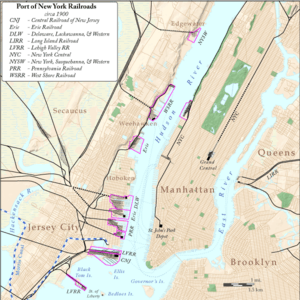
During the latter half of the 19th and early part of the 20th centuries, Hudson experienced intense industrial, commercial and residential growth. Construction, first of ports, and later railroad terminals, in Jersey City, Bayonne, Hoboken, and Weehawken (which significantly altered the shoreline with landfill) fueled much of the development. European immigration, notably German-language speakers and Irish (many fleeing famine) initiated a population boom that would last for several decades.
Neighborhoods grew as farms, estates, and other holdings were sub-divided for housing, civic and religious architecture. Streets (some with trolley lines) were laid out. Stevens Institute of Technology and Saint Peter's University were established.
Before the opening, in 1910, of the Pennsylvania Railroad's North River Tunnels under the Hudson, trains terminated on the west bank of the river, requiring passengers and cargo to travel by ferry or barge to New York. Transfer to the Hudson and Manhattan Railroad tubes (now PATH) became possible upon its opening in 1908. Hoboken Terminal, a national historic landmark originally built in 1907 by the Delaware, Lackawanna and Western Railroad to replace the previous one, is the only one of five major rail/ferry terminals that once dotted the waterfront still in operation. West Shore Railroad Terminal in Weehawken, Erie Railroad's Pavonia Terminal and Pennsylvania Railroad's Exchange Place in Jersey City were all razed.
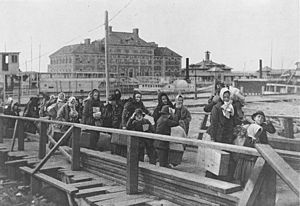
Central Railroad of New Jersey's Communipaw Terminal, across a small strait from Ellis Island and the Statue of Liberty, played a crucial role in the massive immigration of the period, with many newly arrived departing the station to embark on their lives in America. Many, though, decided to stay, taking jobs on the docks, the railroads, the factories, the refineries, and in the sweatshops and skyscrapers of Manhattan. Many manufacturers, whose names read as a "Who's Who" in American industry established a presence, including Colgate, Dixon Ticonderoga, Maxwell House, Standard Oil, and Bethlehem Steel.
North Hudson, particularly Union City became the schiffli "embroidery capital of America". The industry included businesses that provided embroidery machines and parts, fabrics, thread, embroidery designs, dying, chemical lace etching, and bleaching. There were hundreds of small shops, each with one or a few machines, producing a wide array of products. Finished embroidery supplied the garment and home goods industries.
Secaucus boasted numerous pig farms and rendering plants. It was during this period that much of the housing stock, namely one and two family homes and low-rise apartment buildings, was built; municipal boundaries finalized, neighborhoods established. Commercial corridors such as Bergenline, Central, Newark and Ocean Avenues came into prominence. Journal Square became a business, shopping, and entertainment mecca, home to The Jersey Journal, after which it is named, and movie palaces such as Loew's Jersey Theater and The Stanley.
World Wars and New Deal


Upon entry into World War I, the U.S. government took over control of the Hamburg-American Line piers in Hoboken under eminent domain, and Hudson became the major point of embarkation for more than three million soldiers, known as "doughboys". In 1916, an act of sabotage literally and figuratively shook the region when German agents set off bombs at the munitions depot in New York Bay at Black Tom. The forerunner of Port Authority of New York and New Jersey was established on April 30, 1921. Huge transportation projects opened between the wars: The Holland Tunnel in 1927, The Bayonne Bridge in 1931, and The Lincoln Tunnel in 1937, allowing vehicular travel between New Jersey and New York City to bypass the waterfront. Hackensack River crossings, notably the Pulaski Skyway, were also built. What was to become New Jersey City University opened. Major Works Progress Administration projects included the construction of stadiums in Jersey City and Union City. Both were named for President Franklin D. Roosevelt, who attended the opening of the largest project of them all, The Jersey City Medical Center, a massive complex built in the Art Deco Style. During this era, the "Hudson County Democratic Machine", known for its cronyism and corruption, with Jersey City mayor Frank Hague at its head was at its most powerful. Industries in Hudson were crucial to the war effort during WWII, including the manufacture PT boats by Elco in Bayonne. Military Ocean Terminal at Bayonne (MOTBY) was opened in 1942 as a U.S. military base and remained in operation until 1999.
Post-war years
After the war maritime and manufacturing industries still dominated the local economy, and union membership provided guarantees of good pay packages. Though some returning servicemen took advantage of GI housing bills and moved to close-by suburbs, many with strong ethnic and familial ties chose to stay. Baseball legend Jackie Robinson made his minor league debut at Roosevelt Stadium and "broke" the baseball color line. Much of Hudson County experienced the phenomenon of ethnic/economic groups leaving and being replaced by others, as was typical of most urban communities of the New York Bay region. When the big businesses decided to follow them or vice versa, Hudson County's socioeconomic differences became more profound. Old economic underpinnings disintegrated. Attempts were made to stabilize the population by demolishing so-called slums and build subsidized middle-income housing and the pockets of so-called "good neighborhoods" came in conflict with those that went into decline. Riots occurred in Jersey City in 1964.
Lower property values allowed the next wave of immigrants, many from Latin America, to rent or buy in the county. North Hudson, particularly Union City, saw many émigrés fleeing the Cuban revolution take up residence. Unlike other urban industrial areas of comparable size, age and density, North Hudson did not experience marked urban decay or a crime wave during the late 20th century, its population and economic base remaining basically stable, in part, because of its good housing stock, tightly knit neighborhoods and satisfactory schools systems.
Pre/post-millennium
The county since the mid-1990s has seen much real estate speculation and development and a population increase, as many new residents purchase existing housing stock as well as condominiums in high- and mid-rise developments, many along the waterfront. What had started as a gentrification in the 1980s became a full-blown "redevelopment" of the area as many suburbanites, transplanted Americans, internationals, and immigrants (most focused on opportunities in NY/NJ region and proximity to Manhattan) began to make the "Jersey" side of the Hudson their home, and the "real-estate boom" of the era encouraged many to seek investment opportunities. The exploitation of certain parts of the waterfront and other brownfields led to commercial development as well, especially along former rail yards. Hudson felt the short- and long-term impact of the destruction of the World Trade Center intensely: its proximity to lower Manhattan made it a place to evacuate to, many residents who worked there lost their jobs (or their lives), and many companies sought office space across the river. Re-zoning, the Hudson-Bergen Light Rail, and New Jersey State land-use policy of transit villages have further spurred construction. Though very urban and with some of the highest residential densities in the United States, the Hudson communities have remained fragmented, due in part to New Jersey's long history of home rule in local government; geographical factors such as Hudson River inlets/canals, the cliffs of the New Jersey Palisades and rail lines; and ethnic/demographic differences in the population. As the county sees more development this traditional perception is challenged.
Demographics
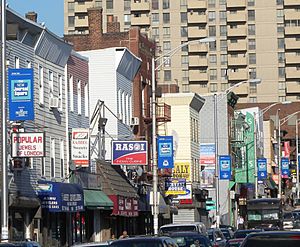
| Historical population | |||
|---|---|---|---|
| Census | Pop. | %± | |
| 1840 | 9,483 | — | |
| 1850 | 21,822 | 130.1% | |
| 1860 | 62,717 | 187.4% | |
| 1870 | 129,067 | 105.8% | |
| 1880 | 187,944 | 45.6% | |
| 1890 | 275,126 | 46.4% | |
| 1900 | 386,048 | 40.3% | |
| 1910 | 537,231 | 39.2% | |
| 1920 | 629,154 | 17.1% | |
| 1930 | 690,730 | 9.8% | |
| 1940 | 652,040 | −5.6% | |
| 1950 | 647,437 | −0.7% | |
| 1960 | 610,734 | −5.7% | |
| 1970 | 607,839 | −0.5% | |
| 1980 | 556,972 | −8.4% | |
| 1990 | 553,099 | −0.7% | |
| 2000 | 608,975 | 10.1% | |
| 2010 | 634,266 | 4.2% | |
| 2020 | 724,854 | 14.3% | |
| 2023 (est.) | 705,472 | 11.2% | |
| Historical sources: 1790-1990 1970-2010 2000 2010-2019 2020 |
|||
Hudson County is the most densely populated county in New Jersey and the sixth-most densely populated county in the United States, with 15,693 residents per square mile (6,130/km2) as of 2020. The only city in Hudson County among the 100 most populous cities in the United States was Jersey City, which was ranked 77th in the United States Census Bureau's rankings based on the 2016 population estimate.
Of municipalities with over 50,000 people, Union City is the most densely populated in the United States, while several Hudson County municipalities are among the most densely populated in the United States as well as worldwide. Guttenburg is the most densely populated municipality in the United States.
North Hudson has the second-largest Cuban American population in the United States behind Miami. Jersey City is the 21st-most ethnically diverse city in the United States and the most ethnically diverse on the East Coast of the United States. Hudson has three communities on the list of the 100 cities (population 5,000 and up) with the highest percent of foreign-born residents: West New York (65.2%), Union City (58.7%), and Guttenberg (48.7%) Hudson County has the smallest proportion of persons over age 65 in New Jersey.
2020 census
As of the 2020 census, the county had 724,854 people, 266,664 households, and 160,697 families. The population density was 15,692.9 inhabitants per square mile (6,059.1/km2). There were 312,706 housing units at an average density of 6,770 per square mile (2,613.9/km2). The county's racial makeup was 28.49% White, 9.84% African American, 0.14% Native American, 17.02% Asian, and 2.75% from two or more races. Hispanic or Latino of any race were 40.4% of the population.
Of the 266,664 households, of which 29.5% had children under the age of 18 living with them, 40.7% were married couples living together, 30.5% had a female householder with no husband present, 21.3% had a male householder with no wife present and 39.73% were non-families. 68.8% of all households were made up of individuals, and 9.2% had someone living alone who was 65 years of age or older. The average household size was 2.49 and the average family size was 3.11.
About 20.3% of the county's population was under age 18, 7.7% was from age 18 to 24, 47.6% was from age 15 to 44, and 12.2% was age 65 or older. The median age was 35.5 years. The gender makeup of the city was 49.76% male and 50.23% female. For every 100 females, there were 99.1 males.
The county's median household income was $78,808, and the median family income was $76,019. About 13.9% of the population were below the poverty line, including 22.2% of those under age 18 and 17.4% of those age 65 or over.
2010 census
The 2010 United States census counted 634,266 people, 246,437 households, and 148,355 families in the county. The population density was 13,731.4 per square mile (5,301.7/km2). There were 270,335 housing units at an average density of 5,852.5 per square mile (2,259.7/km2). The racial makeup was 54.05% (342,792) White, 13.23% (83,925) Black or African American, 0.64% (4,081) Native American, 13.39% (84,924) Asian, 0.05% (344) Pacific Islander, 14.25% (90,373) from other races, and 4.39% (27,827) from two or more races. Hispanic or Latino of any race were 42.23% (267,853) of the population.
Of the 246,437 households, 27.6% had children under the age of 18; 37.8% were married couples living together; 16.4% had a female householder with no husband present and 39.8% were non-families. Of all households, 29.9% were made up of individuals and 8.3% had someone living alone who was 65 years of age or older. The average household size was 2.54 and the average family size was 3.2.
20.7% of the population were under the age of 18, 10% from 18 to 24, 36% from 25 to 44, 22.9% from 45 to 64, and 10.4% who were 65 years of age or older. The median age was 34.2 years. For every 100 females, the population had 97.9 males. For every 100 females ages 18 and older there were 95.9 males.
Community diversity
Hudson County is a major port of entry for immigration to the United States and a major employment center at the approximate core of the New York City metropolitan region; and given its proximity to Manhattan, Hudson County has evolved a globally cosmopolitan ambience of its own, demonstrating a robust and growing demographic and cultural diversity with respect to metrics including nationality, religion, race, and domiciliary partnership. Cuba, Dominican Republic, Ecuador, Philippines, and India are the five most common nations of birth for foreign-born Hudson County residents. Jersey City is one of the most ethnically diverse cities in the world.
Latin American
There were an estimated 273,611 Hispanic Americans in Hudson County, according to the 2013 American Community Survey, representing a 2.1% increase from 267,853 Hispanic Americans enumerated in the 2010 United States Census. Several municipalities in northern Hudson County are listed among those places in the United States with the highest population densities, with several towns more dense overall than adjacent New York City. Numerous towns on the Hudson Palisades in northern Hudson County have populations where more than 50% of the residents are foreign-born, often with a Hispanic majority.
Puerto Rican American
There were an estimated 58,197 Puerto Rican Americans in Hudson County, according to the 2013 American Community Survey, representing a 3.1% increase from 56,436 Puerto Rican Americans enumerated in the 2010 United States Census.
Cuban American
There were an estimated 28,900 Cuban Americans in Hudson County, according to the 2013 American Community Survey, representing a 0.9% increase from 28,652 Cuban Americans enumerated in the 2010 United States Census. The Cuban Day Parade of New Jersey, since its inception at the millennium, has run along Bergenline Avenue and grown to be the centerpiece of large festivities which have taken place at Scheutzen Park or Celia Cruz Park.
European American
There were an estimated 194,192 non-Hispanic whites in Hudson County, according to the 2013 American Community Survey, representing a 0.7% decrease from 195,501 non-Hispanic whites enumerated in the 2010 United States Census.
Italian American
Italian Americans have historically played an important cultural role in Hudson County.
Western European American
Ever since the settling of New Netherland in the 1600s, comprising what is now the Gateway Region of northeastern New Jersey as well as portions of Downstate New York in the New York City metropolitan area, the Dutch and British, along with German and Irish Americans, have established an integral role in the subsequent long-term development of Hudson County over the centuries.
Irish American
Irish Americans, specifically Irish Catholics played a significant role in the politics of Jersey City. Many of the city's mayors were of Irish descent. The Greenville, Jersey City neighborhood was the center of the city's Irish community until the 1950s and early 1960s.
Asian American
There were an estimated 89,164 Asian Americans in Hudson County, according to the 2013 American Community Survey, representing a 5.0% increase from 84,924 Asian Americans enumerated in the 2010 United States Census.
Indian American
India Square, also known as "Little India" or "Little Bombay", home to the highest concentration of Asian Indians in the Western Hemisphere, is a rapidly growing Indian American ethnic enclave in Jersey City. This area has been home to the largest outdoor Navratri festivities in New Jersey as well as several Hindu temples; while an annual, color-filled spring Holi festival has taken place in Jersey City since 1992, centered upon India Square and attracting significant participation and international media attention. There were an estimated 39,477 Indian Americans in Hudson County, according to the 2013 American Community Survey, representing a 6.0% increase from 37,236 Indian Americans enumerated in the 2010 United States Census.
Filipino American
7% of Jersey City's population is Filipino. The Five Corners district is home to a thriving Filipino community and Jersey City's Little Manila, which is the second largest Asian American subgroup in the city. A variety of Filipino restaurants, shippers and freighters, doctors' officers, bakeries, stores, and an office of The Filipino Channel have made Newark Avenue their home. The largest Filipino-owned grocery store on the East Coast of the United States, Phil-Am Food, has been there since 1973. An array of Filipino-owned businesses can also be found at the section of West Side of Jersey City, where many of its residents are of Filipino descent. In 2006, a Red Ribbon pastry shop, one of the Philippines' most famous food chains, opened its first branch on the East Coast in the Garden State.[1] Manila Avenue in Downtown Jersey City was named for the Philippine capital city because of the many Filipinos who built their homes on this street during the 1970s. A memorial, dedicated to the Filipino American veterans of the Vietnam War, was built in a small square on Manila Avenue. A park and statue dedicated to Jose P. Rizal, a national hero of the Philippines, exists in downtown Jersey City. Jersey City is the host of the annual Philippine-American Friendship Day Parade, an event that occurs yearly in June, on its last Sunday. The City Hall of Jersey City raises the Philippine flag in correlation to this event and as a tribute to the contributions of the Filipino community. The Santakrusan Procession along Manila Avenue has taken place since 1977. There were an estimated 21,622 Filipino Americans in Hudson County, according to the 2013 American Community Survey, representing a 4.8% increase from 20,638 Filipino Americans enumerated in the 2010 United States Census.
Chinese American
Hudson County, highly accessible to Lower Manhattan in New York City and its Chinatown by rapid transit, was home to an estimated 13,381 Chinese Americans, according to the 2013 American Community Survey, representing a notably rapid growth of 19.1% from the 11,239 Chinese Americans enumerated in the 2010 United States Census.
African American
There were an estimated 83,576 African Americans in Hudson County, according to the 2013 American Community Survey, representing a 0.4% decrease from 83,925 African Americans enumerated in the 2010 United States Census. However, modest growth in the African immigrant population, most notably the growing Nigerian American population in Jersey City, is partially offsetting the decline in Hudson County's American-born black population, which as a whole has been experiencing an exodus from northern New Jersey to the Southern United States.
Arab American
Arab Americans numbered an estimated 14,518 individuals in Hudson County in the 2012 American Community Survey, representing 2.3% of the county's total population, the second highest percentage in New Jersey after Passaic County. Arab Americans are most concentrated in Jersey City and Bayonne, led by Egyptian Americans, including the largest population of Coptic Christians in the United States.
Muslim American
Hudson County's Muslim American population includes a significant Latino contingent comprising adherents converting from other religious affiliations.
Jewish American
A growing Jewish American population has been noted in Hudson County, particularly in Jersey City. A significant Jewish presence has also been established in Bayonne.
Economy
The Bureau of Economic Analysis calculated that the county's gross domestic product was $41.7 billion (~$41.7 billion in 2021) in 2021, which was ranked fifth in the state and was a 5.7% increase from the prior year.
Various businesses and industries are headquartered or had their start in Hudson County. Secaucus is home to The Vitamin Shoppe, My Network TV's flagship station WWOR-TV, Red Bull New York, MLB Network, NBA Entertainment, Goya Foods, The Children's Place and Hartz Mountain. Jersey City is home to Verisk Analytics and WFMU 91.1FM (WMFU 90.1FM in the Hudson Valley), the longest running freeform radio station in the United States. Hoboken is the birthplace of the first Blimpie restaurant, and home to one of the headquarters of publisher John Wiley & Sons. In the 20th century, Union City was the "embroidery capital of the United States", the trademark of that industry appearing on that city's seal. Weehawken is home to the headquarters of NY Waterway, as well as offices for Swatch Group USA, UBS and Hartz Mountain.
Television producers had long held an attraction for New Jersey, and Hudson County in particular, due to the tax credits afforded such various productions. The HBO prison drama Oz was filmed in an old warehouse in Bayonne, with much of the series filmed around the now-defunct Military Ocean Terminal Base. The NBC drama Law and Order: Special Victims Unit filmed police station and courtroom scenes at NBC's Central Archives building in North Bergen, and filmed other scenes throughout the county, such as a 2010 episode filmed at the Meadowlands Parkway in Secaucus. The short-lived hospital drama Mercy filmed at a warehouse in Secaucus, a private residence in Weehawken and a public school in Jersey City. The Law and Order and Mercy productions left New Jersey for New York in 2010 after New Jersey Governor Chris Christie suspended the tax credits for film and television production for the Fiscal Year 2011 to close budget gaps.
Municipalities
There are 12 municipalities in Hudson County, listed with area in square miles and 2010 Census data for population and housing. North Hudson and West Hudson each comprise municipalities in their distinct areas.
| Municipality | Map key |
Mun. type |
Pop. | Housing units |
Total area |
Water area |
Land area |
Pop. density |
Housing density |
School district |
|---|---|---|---|---|---|---|---|---|---|---|
| Bayonne | 1 | city | 71,686 | 27,799 | 11.08 | 5.28 | 5.80 | 10,858.3 | 4,789.4 | Bayonne |
| East Newark | 10 | borough | 2,594 | 794 | 0.12 | 0.02 | 0.10 | 23,532.1 | 7,765.8 | Harrison (9-12) (S/R) East Newark (K-8) |
| Guttenberg | 6 | town | 12,017 | 4,839 | 0.24 | 0.05 | 0.20 | 57,116.0 | 24,730.2 | North Bergen (9-12) (S/R) Guttenberg (PK-8) |
| Harrison | 9 | town | 19,450 | 5,228 | 1.32 | 0.12 | 1.20 | 11,319.3 | 4,344.9 | Harrison |
| Hoboken | 3 | city | 60,419 | 26,855 | 2.01 | 0.74 | 1.28 | 39,212.0 | 21,058.7 | Hoboken |
| Jersey City | 2 | city | 292,449 | 108,720 | 21.08 | 6.29 | 14.79 | 16,736.6 | 7,349.1 | Jersey City |
| Kearny | 8 | town | 41,999 | 14,180 | 10.19 | 1.42 | 8.77 | 4,636.5 | 1,616.0 | Kearny |
| North Bergen | 11 | township | 63,361 | 23,912 | 5.57 | 0.44 | 5.13 | 11,838.0 | 4,657.8 | North Bergen |
| Secaucus | 7 | town | 22,181 | 6,846 | 6.60 | 0.78 | 5.82 | 2,793.7 | 1,175.9 | Secaucus |
| Union City | 4 | city | 68,589 | 24,931 | 1.28 | 0.00 | 1.28 | 51,810.1 | 19,436.9 | Union City |
| Weehawken | 12 | township | 17,197 | 6,213 | 1.48 | 0.68 | 0.80 | 15,764.6 | 7,801.9 | Weehawken |
| West New York | 5 | town | 52,912 | 20,018 | 1.33 | 0.32 | 1.01 | 49,341.7 | 19,870.5 | West New York |
| Hudson County | county | 724,854 | 270,335 | 62.31 | 16.12 | 46.19 | 13,731.4 | 5,852.5 |
Education
Tertiary education
The colleges and universities in Hudson County are Hudson County Community College (HCCC), New Jersey City University (NJCU), Saint Peter's University (all in Jersey City) and Stevens Institute of Technology (in Hoboken). Rutgers University also offers classes within the county. The Christ Hospital School of Nursing was established in 1890 and has run a cooperative program with HCCC since 1999. As of 2014, it was set to merge with the Bayonne Medical Center School of Nursing.
School districts
Each municipality has a public school district. All but two have their own public high schools. East Newark students attend Harrison High School and Guttenberg students attend North Bergen High School. Hudson County Schools of Technology is a public secondary and adult vocational-technical school with locations in Secaucus, Jersey City, Union City and Harrison. There are public and private elementary and secondary schools located throughout Hudson, many of which are members of the Hudson County Interscholastic Athletic Association.
School districts, all classified as K-12 (except as indicated), include:
- Bayonne School District
- East Newark School District (K–8)
- Guttenberg Public School District (K–8)
- Harrison Public Schools
- Hoboken Public Schools
- Hudson County Schools of Technology (9–12)
- Jersey City Public Schools
- Kearny School District
- North Bergen School District
- Secaucus Public Schools
- Union City School District
- Weehawken School District
- West New York School District
Transportation
The confluence of roads and railways of the Northeastern U.S. megalopolis and Northeast Corridor passing through Hudson County make it one of the Northeast's major transportation crossroads and provide access to an extensive network of interstate highways, state freeways and toll roads, and vehicular water crossings. Many long-distance trains and buses pass through the county, though Amtrak and the major national bus companies – Greyhound Lines and Trailways – do not provide service within it. There are many local, intrastate, and Manhattan-bound bus routes, an expanding light rail system, ferries traversing the Hudson, and commuter trains to North Jersey, the Jersey Shore, and Trenton. Much of the rail, surface transit, and ferry system is oriented to commuters traveling to Newark, lower and midtown Manhattan, and the Hudson Waterfront. Public transportation is operated by a variety of public and private corporations, notably NJ Transit, the Port Authority of New York and New Jersey, and NY Waterway, each of which charge customers separately for their service. Hudson is the only county in New Jersey where more residents (127,708) used public transportation than who drove (124,772).
Hubs
Hoboken Terminal, Bergenline Avenue at 32nd Street, 48th Street, and Nungessers in North Hudson, and Journal Square Transportation Center and Exchange Place in Jersey City are major public transportation hubs. The Port Authority Bus Terminal and Penn Station in Midtown Manhattan, the World Trade Center in Lower Manhattan, and Newark Penn Station also play important roles within the county's transportation network. Secaucus Junction provides access to eight commuter rail lines.
Rail
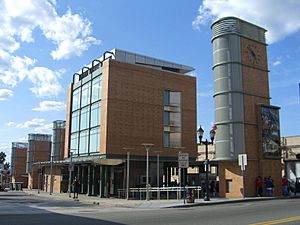
- Hudson-Bergen Light Rail serves Bayonne, Jersey City, Hoboken, and North Hudson at the Weehawken waterfront, Bergenline Avenue and Tonnelle Avenue.
- NJ Transit Hoboken Division: Main Line (to Suffern, and in partnership with MTA/Metro-North, express service to Port Jervis), Bergen County Line, and jointly with MTA/Metro-North, Pascack Valley Line, all via Secaucus Junction; Montclair-Boonton Line and Morris and Essex Lines; North Jersey Coast Line (limited service as Waterfront Connection); Raritan Valley Line (limited service), and Meadowlands Rail Line
- NJ Transit Newark Division: Northeast Corridor Line and North Jersey Coast Line can be reached via Secaucus Junction or PATH
- PATH is a 24-hour subway mass transit system serving Newark Penn Station, Harrison, Journal Square, Downtown Jersey City, Hoboken Terminal, midtown Manhattan (33rd) (along 6th Ave to Herald Square/New York Penn Station), and World Trade Center.
Bus
NJ Transit bus routes 120 -129 provide service within Hudson and to Manhattan. NJ Transit bus routes 1-89 provide service within the county and to points in North Jersey. Additionally, private bus companies, some of which operate dollar vans (mini-buses or carritos) augment the state agency's surface transport.
Water
Located at the heart of the Port of New York and New Jersey, Hudson County has since the 1980s seen the restoration of its once extensive ferry system.
- NY Waterway operates ferry service from Weehawken Port Imperial, Hoboken Terminal, and Paulus Hook Ferry Terminal as well as other ferry slips along the Hudson River Waterfront Walkway to West Midtown Ferry Terminal, Battery Park City Ferry Terminal and Pier 11/Wall Street in Manhattan, and to the Raritan Bayshore
- Liberty Water Taxi provides service on one route between Liberty State Park, Paulus Hook, and Battery Park City.
- Statue Cruises provides service to Ellis Island and Liberty Island
- Cape Liberty Cruise Port in Bayonne is one of three passenger terminals in the port.
- Port Jersey is one of four container shipping terminals in the port.
Roads and highways
As of 2010[update], the county had a total of 616.81 miles (992.66 km) of roadways, of which 515.38 miles (829.42 km) are maintained by the local municipality, 47.31 miles (76.14 km) by Hudson County, 33.23 miles (53.48 km) by the New Jersey Department of Transportation, 17.90 miles (28.81 km) by the New Jersey Turnpike Authority and 3.37 miles (5.42 km) by the Port Authority of New York and New Jersey.
Major highways include New Jersey Routes 3, 7, 139, 185, 440, 495, Interstates 78, 95, and 280, and U.S. Routes 1/9 and 1/9 Truck, as well as the New Jersey Turnpike and the Pulaski Skyway. Automobile access to New York City is available through the Lincoln Tunnel (via Weehawken to Midtown Manhattan) and the Holland Tunnel (via Jersey City to Lower Manhattan), and over the Bayonne Bridge to Staten Island. County Route 501 runs the length of Hudson as Kennedy Boulevard.
In 2013, two main thoroughfares in Hudson County, Kennedy Boulevard and U.S. Route 1/9, were included among the Tri-State Transportation Campaign's list of the top ten most dangerous roads for pedestrians in New Jersey, New York and Connecticut. Kennedy Boulevard was ranked #6 for the six pedestrian fatalities that occurred on it from 2009 to 2011, while Route 1/9 was tied for the #10 place on the list for the five pedestrian deaths during the same period. Route 1/9 is monitored by state police, while Kennedy Boulevard is patrolled by the Hudson County Sheriff's Office and the respective municipalities through which that road runs. In total, 37 pedestrians – 12 in 2009, 14 in 2010 and 11 in 2011 – were killed on Hudson County roads. According to state police statistics there were nine pedestrian fatalities in the county in 2012, which was not included in the study. From 2010 through 2012, 25 people were killed each year in Hudson County motor vehicle accidents.
Air
Most airports which serve Hudson County are operated by the Port Authority of New York and New Jersey
- Newark Liberty International Airport (EWR), 12.8 miles (20.6 km) away in Newark, is the closest airport with scheduled passenger service
- LaGuardia Airport (LGA) is 12.8 miles (20.6 km) away in Flushing, Queens
- John F. Kennedy Airport (JFK) is 19 miles (31 km) away on Jamaica Bay in Queens
- Teterboro Airport, in the Hackensack Meadowlands, serves private and corporate planes
- Essex County Airport, in Fairfield, is a general aviation airport serving the region
Parks and points of interest
The Hudson County Park System includes Hudson County Park, Mercer Park, Lincoln Park, Washington Park, Columbus Park, and North Hudson Park, West Hudson Park and the newest, Laurel Hill. Some of the city's municipal parks and plazas, were developed as "city squares" during the 19th century, such as Hamilton Park, Church Square Park and Ellsworth (locally known as Pigeon) Park.
The German-American Volksfest has taken place annually since 1874 at Schuetzen Park This private park and the many nearby cemeteries-Flower Hill Cemetery, Grove Church Cemetery, Hoboken Cemetery, Macphelah Cemetery and Weehawken Cemetery that characterize the western slope create the "green lung" of North Hudson County.
Jersey City Reservoir No.3 and Pershing Field constitute one of the largest "green spaces" in the county. The reservoir, no longer in use, is site of a passive recreation area/nature preserve. Hackensack Number Two, the other remaining reservoir in Weehawken Heights, is not accessible to the public. Extensive athletic fields opened in 2009 in Weehawken and Union City, the latter on the site of the former Roosevelt Stadium.
Promenades are being developed along the rivers. The Hudson River Waterfront Walkway and Hackensack RiverWalk. Sections of the Secaucus Greenway are in place and eventually will connect different districts of the town including the North End, site Schmidts Woods (which contains an original hard wood forest) and Mill Creek Point Park, and Harmon Meadow Plaza. Kearny Riverbank Park runs along the Passaic River. The future of the Harsimus Stem Embankment is uncertain, though many community groups hope the landmark will be opened to the public as elevated greenway, possibly as part of East Coast Greenway.
Liberty State Park, the county's largest, is sited on land that had once been part of a vast oyster bed, was filled in for industrial, rail, and maritime uses, and was reclaimed in the 1970s. Ellis Island and Liberty Island, a national protected area and home to the Statue of Liberty National Monument, lie entirely within Hudson's waters across from Liberty State Park, from which ferry service is available.
The New Jersey Meadowlands Commission has designated several areas within its jurisdiction as wetlands preservation zones including the Riverbend Wetlands Preserve, Eastern Brackish Marsh, and Kearny Marsh, an extension of De Korte Park, home of the Meadowlands Environment Center.
Hudson County is home to Skyway Golf Course, the 8th ranked 9 hole golf course in the country (Golf Advisor 2019), Bayonne Golf Club and Liberty National Golf Club, ball located on Upper New York Bay.
- See Historic districts in Hudson County, New Jersey
- See Odonyms in Hudson County, New Jersey
- See List of cemeteries in Hudson County, New Jersey
- See List of the oldest buildings in New Jersey
- See List of bridges, tunnels, and cuts in Hudson County, New Jersey
Museums, galleries, exhibitions
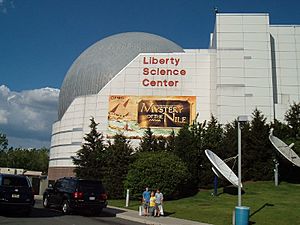
There are several museums and other exhibitions spaces throughout the county, some of which maintain permanent collections. Other are focused on local culture, history, or the environment. There are events throughout the year where architecture, local artists or ethnic culture are highlighted. There are also private galleries. The venues include:
- Afro-American Historical and Cultural Society Museum
- Bayonne Community Museum
- Bayonne Firefighter's Museum
- Central Railroad of New Jersey Terminal
- Cultural Thread/El Hilo, history, diversity and craft of embroidery
- Danforth Avenue Station, excavated objects
- Dixon Mills, site of the former Joseph Dixon Crucible Company
- Drawing Rooms, a contemporary art center and gallery in a former convent in downtown Jersey City
- Ellis Island Immigration Museum
- Five Corners Branch Library Gallery specializes in music and fine arts.
- Hoboken Artists Studio Tour
- Hoboken Fire Department Museum
- Hoboken Historical Museum history and local contemporary artists
- Hoboken House Tour private and public buildings shown annually in October
- Hoboken Public Library, local history and local artists
- Hudson County Courthouse permanent murals depicting early history and contemporary work
- Hudson River Waterfront Walkway displays, plaques, panels of history of environment and development
- Kearny Museum
- Hudson County YAM
- Jersey City Artists Studio Tour
- Jersey City Museum
- Liberty Science Center Science education, environment, health, invention
- Liberty State Park Interpretive Center, nature and urban environment
- Museum of Russian Art
- New Jersey Room of Jersey City Public Library Main Branch, public archives including historical documents and photos
- Mana Contemporary
- Martin Luther King Station memorial to civil rights leader and movement
- Meadowlands Exposition Center, trade shows and cultural fairs
- Monroe Center
- New Jersey City University
- Lemmerman Gallery
- Visual Arts Gallery
- Sculpture Garden
- Saints Peter's College Art Gallery
- Statue of Liberty National Monument
- William V. Musto Cultural Center
See also
 In Spanish: Condado de Hudson para niños
In Spanish: Condado de Hudson para niños



